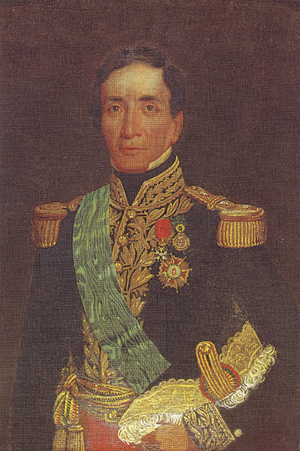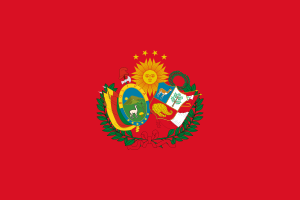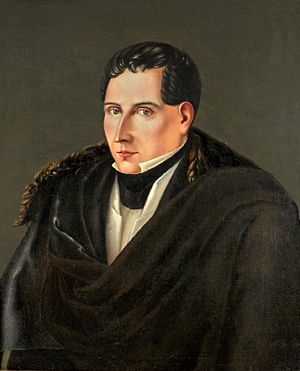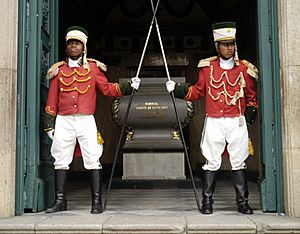Andrés de Santa Cruz facts for kids
Quick facts for kids
Marshal
Andrés de Santa Cruz
|
|
|---|---|

Portrait by Manuel Ugalde, c. 1835
|
|
| Supreme Protector of the Peru–Bolivian Confederation | |
| In office 28 October 1836 – 20 February 1839 |
|
| Preceded by | Office established |
| Succeeded by | Office abolished José Miguel de Velasco (as president of Bolivia) Agustín Gamarra (as president of Peru) |
| 6th President of Bolivia | |
| In office 24 May 1829 – 20 February 1839 Provisional: 24 May 1829 – 15 August 1831 |
|
| Vice President | José Miguel de Velasco (1829–1835) Mariano Enrique Calvo(1835–1839) |
| Preceded by | José Miguel de Velasco (acting) |
| Succeeded by | José Miguel de Velasco (provisional) |
| 2nd President of Peru | |
| In office 29 June 1826 – 9 June 1827 |
|
| Preceded by | Simón Bolívar |
| Succeeded by | Manuel Salazar y Baquíjano (acting) |
| President of the Council of Government | |
| In office 30 November 1826 – 7 June 1827 Acting: 29 June 1826 – 30 November 1826 |
|
| President | Simón Bolívar |
| Preceded by | Hipólito Unanue |
| Succeeded by | Manuel Salazar y Baquíjano (as vice president) |
| Personal details | |
| Born | 5 December 1792 Huarina, Upper Peru, Viceroyalty of the Río de la Plata |
| Died | 25 September 1865 (aged 72) Beauvoir, France |
| Spouse | Francisca Cernadas |
| Signature | |
Andrés de Santa Cruz y Calahumana (born December 5, 1792 – died September 25, 1865) was an important general and politician from Bolivia. He served as President of Bolivia and also led the Peru–Bolivian Confederation as its Supreme Protector. This confederation was a big project he worked hard to create.
Contents
Early Life and Education
Andrés de Santa Cruz was born in Huarina, a town in La Paz. His father was from Spain, and his mother was an Amerindian leader (a cacique) from Huarina. Andrés de Santa Cruz later said that his mother's family were direct descendants of the ancient Inca rulers.
He started his education at a convent in his hometown. Later, he continued his studies at a Seminary in Cuzco. In 1809, he left the seminary and went back to La Paz.
Military Career Begins
When Santa Cruz returned home, his father helped him join the Spanish Army as an alférez (a junior officer). He fought in several battles, including Battle of Guaqui (1811), Battle of Vilcapugio (1813), and Battle of Ayohuma (1813). These battles were against Argentine forces who were trying to free Upper Peru (which is now Bolivia) from Spanish rule.
Santa Cruz also helped the Spanish Crown stop a rebellion led by Mateo Pumacahua. However, he was captured at the Battle of La Tablada in 1817. He managed to escape and traveled to Rio de Janeiro and then to Lima. As a reward for his loyalty, he was made Commander of Chorrillos.
Fighting for Independence
When the rebel army, led by José de San Martín, arrived in Peru, Santa Cruz was a commander of local forces. He first fought against the independence fighters. But after being captured at the Battle of Pasco in 1820, he decided to switch sides and join the Patriot Army in 1821.
Santa Cruz quickly rose through the ranks. He became a Colonel and then a Brigade General in 1822. He led Peruvian troops in the Battle of Pichincha. In 1823, he briefly went against the Peruvian Congress, helping to make José de la Riva Agüero president. He also led an expedition that won the Battle of Zepita.
When Simón Bolívar became president of Peru in 1824, Santa Cruz joined his army. He became Chief of Staff of the Peruvian forces. He fought in the Battle of Junín and later helped free Bolivia. For his efforts, he was given the titles of Marshal and Prefect of Chuquisaca in 1825.
Santa Cruz was in charge of the Peruvian government after Bolívar returned to Gran Colombia in 1826. He served as temporary president until 1827.
President of Bolivia
After leaving his post in Peru, Santa Cruz was called to Bolivia, where he was chosen to be President. He took office on May 24, 1829. At this time, Bolivia was facing many problems, including internal conflicts and financial difficulties.
Santa Cruz worked hard to fix these issues. He took several important steps:
- He removed people who were plotting against the government.
- He made the Army stronger.
- He improved the government's organization.
- He reformed the country's finances and created new currency.
- He introduced a new Constitution and a new Civil Code, which was similar to the French Napoleonic Code.
- He established Cobija as a free port to help trade.
His strong leadership brought stability to Bolivia when many other countries in Latin America were struggling. This stability also helped him pursue his biggest goal: creating the Peru-Bolivian Confederation.
The Peru-Bolivian Confederation
As President of Bolivia, Santa Cruz wanted to unite Bolivia with Peru. He tried several times, especially when Peru was having political problems. His best chance came in 1835. The Peruvian President, Luis José de Orbegoso, asked Santa Cruz for help against a rebel army.
Santa Cruz defeated the rebel leaders, Agustín Gamarra at the Battle of Yanacocha (1835) and Felipe Santiago Salaverry at the Battle of Uchumayo (1836). After defeating Salaverry, Santa Cruz had him executed.
Santa Cruz then encouraged parts of Peru to form new states. The southern departments of Peru formed the South Peru Republic in March 1836. The northern departments formed the Republic of North Peru in August 1836. Both new republics recognized Santa Cruz as their Supreme Protector. This allowed him to create the Peru-Bolivian Confederation on October 28, 1836.
He gathered representatives from both Peruvian legislatures and the Bolivian Congress in Tacna. On May 1, 1837, they signed a pact that made him Supreme Protector for ten years.
With his new powers, Santa Cruz tried to bring the same order to Peru that he had brought to Bolivia. He introduced new laws for civil matters, crime, trade, and customs. He also improved how taxes were collected, which increased government money.
However, many people in both Peru and Bolivia did not like the Confederation. They felt it weakened their own national identities. Many Peruvian politicians who were against the Confederation went to Chile. There, they got support from a powerful Chilean minister named Diego Portales.
Together, they organized a military expedition against Santa Cruz. The Chilean forces, led by Admiral Manuel Blanco Encalada, were surrounded by Santa Cruz's army. They had to surrender and sign the Treaty of Paucarpata in November 1837. But the Chilean Government organized a second expedition. This time, they defeated Santa Cruz at the Battle of Yungay on January 20, 1839. This defeat led to the end of the Confederation.
Later Years and Legacy
After the Confederation ended, Santa Cruz resigned as Supreme Protector on February 20, 1839. He fled to Ecuador and tried to regain power, but he was unsuccessful. In 1843, he landed in Peru but was captured while trying to reach Bolivia. He was sent to the Chilean Government and imprisoned until 1846.
After his release, he served as an ambassador to several European countries. He later ran for president of Bolivia but lost. He spent the rest of his life in France, near Nantes. He died on September 25, 1865, and was buried in Cemetery of Notre-Dame, Versailles, France.
One hundred years later, in 1965, his remains were brought back to Bolivia. They were reburied with a special ceremony at the Cathedral Basilica of Our Lady of Peace, La Paz, next to the Presidential Palace.
See Also
 In Spanish: Andrés de Santa Cruz para niños
In Spanish: Andrés de Santa Cruz para niños
- History of Bolivia
- History of Peru
- Peru-Bolivian Confederation
- War of the Confederation




